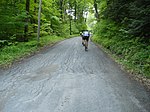Lake Buel

Lake Buel is a 196-acre (0.79 km2) great pond in Berkshire County, Massachusetts just south of Route 57 and east of Great Barrington. It is surrounded by over one-hundred summer homes and a few dozen year-round homes in about a dozen separate, tight-knit neighborhoods, each with its own private or semi-private road. The roads do not interlink.The lake is named after Samuel C. Buel of Tyringham, Massachusetts who saved people from drowning on the lake (called at the time Six Mile Pond) on July 23, 1812.The northern shore of the lake is in the town of Monterey and the southern shore is in New Marlborough. There is a paved boat ramp on the northwest shore owned by the Public Access Board and managed by Forests and Parks and Fisheries and Game. A portion of the Appalachian Trail crosses over a breached mill dam along the northern inlet.
Excerpt from the Wikipedia article Lake Buel (License: CC BY-SA 3.0, Authors, Images).Lake Buel
Heberts Cove,
Geographical coordinates (GPS) Address Nearby Places Show on map
Geographical coordinates (GPS)
| Latitude | Longitude |
|---|---|
| N 42.169444444444 ° | E -73.275 ° |
Address
Heberts Cove 14
Massachusetts, United States
Open on Google Maps








